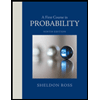
A First Course in Probability (10th Edition)
10th Edition
ISBN: 9780134753119
Author: Sheldon Ross
Publisher: PEARSON
expand_more
expand_more
format_list_bulleted
Question

Transcribed Image Text:Let Ybe an exponentially distributed random variable with mean 3. Define a random variable X in the
following way: X= kif k-1 ≤Y<k for k = 1, 2, . . . .
a Find P(X= k) for each k = 1, 2,....
b Show that your answer to part (a) can be written as
P(X = k) = (e¯¹/³)^−¹ (1 – e¯¹/B), k = 1, 2,...
and that X has a geometric distribution with p = (1 − e¯¹/³).
Expert Solution
This question has been solved!
Explore an expertly crafted, step-by-step solution for a thorough understanding of key concepts.
Step by stepSolved in 4 steps with 5 images

Knowledge Booster
Similar questions
- Q1. let Y₁ < Y₂ < Y3 < Y4 < Y5 are the order statistics of the random sample of size 5 from the distribution : f(x) = 3x², 0arrow_forwardSuppose X is a normal random variable with mean u = 17.5 and o = 6. A random sample of size n = 24 is selected from this population. a. Find the distribution of b. Find P(X < 14) and P(X < 14) Find P(15arrow_forward4. Let X - N(u, o²). The characteristic function (ch.f.) of X is given by $(w) = ejHw-o?w?/2, W E R, where j = v-1 is the imaginary unit. Use the ch.f. to find the mean and variance of X.arrow_forward
arrow_back_ios
arrow_forward_ios
Recommended textbooks for you
 A First Course in Probability (10th Edition)ProbabilityISBN:9780134753119Author:Sheldon RossPublisher:PEARSON
A First Course in Probability (10th Edition)ProbabilityISBN:9780134753119Author:Sheldon RossPublisher:PEARSON

A First Course in Probability (10th Edition)
Probability
ISBN:9780134753119
Author:Sheldon Ross
Publisher:PEARSON
